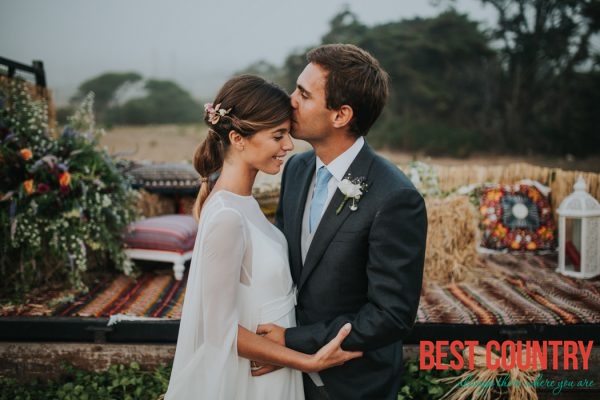Portugal is a ancient and once-powerful country rich with tradition and heritage, including many ancient wedding customs.
Portuguese Wedding Traditions
 Today more than 99% of all Portuguese are Roman Catholic and most weddings over the past 30 years or so have been patterned after the modern religious ceremonies in the United States and Western Europe.
Today more than 99% of all Portuguese are Roman Catholic and most weddings over the past 30 years or so have been patterned after the modern religious ceremonies in the United States and Western Europe.
That’s not to say that there is nothing of the old customs in the modern ceremonies of today. Even today it is customary for the oldest members of the community to attend a stag party for the groom at which he bids farewell to his single life and his single friends.
It is also still customary, as it was in ancient times, for friends and neighbors to lend a hand wherever they can to help with the celebration and with the wedding itself.
Also, the ancient custom of passing around the bride’s shoe during the reception and stuffing it with money to help the young couple with their honeymoon and to help them start their new life together is still very much alive.
Recently, however, there has bit somewhat of a revival in the ancient wedding customs. More and more couples are now opting for the romanticism and tradition of the more ancient wedding customs handed down from generation to generation.
Past wedding traditions are enjoying a rebirth.
In days past it was customary for the groom to send a friend or a relative to ask the prospective bride’s father if he could ask for the daughter’s hand in marriage.
If the father agreed then the young man would formally ask for the girl’s hand in marriage and the marriage was allowed to take place.
There are a few of the old traditions which are not practiced even by couples wishing to wed the old-fashioned way.
For example, there was a tradition in which the prospective bride would pretend to be a cow that needed to be recognized by its owner, her soon-to-be husband. Customs such as these are usually skipped over.
For the ceremony the traditional bride wears a white Chinese tunic covered with colorful jewels.
The groom wears a dark suit, white shirt, and a stylish dark top hat. At the conclusion of the ceremony, as the bride and groom are placing their wedding bands on each other’s hand, the priest covers the couple with his stole.
Then, as the happy couple exit the church, their friends and family throw flowers and candies in the same way that other cultures toss rice or wheat.
Following the ceremony the couple parades through the streets, where friends, family and even complete strangers wish them happiness in their new life together. The couple then have a quiet time together, where they traditionally drink tea and eat small cakes.
The following day the couple visit all of their wedding guests and personally thank each one for attending their wedding.
A blending of old and new traditions
Today the young couple is more likely to go to a wedding reception following the marriage ceremony.
The reception is held either at a home or, more commonly today, in a restaurant. During the reception there is much traditional music, dancing, plenty of sea food and other delicacies, and much wine.
Portugal is known for its wine and wedding guests are known for their frequent toasts to the happy couple.
At the reception there is much dancing and laughing and the telling of stories about the bride and the groom.
There is also, traditionally, a money dance, during which young men pay for the privilege of dancing with the bride or during which the bride’s shoe is passed around the dance floor and is filled with money to help the new couple get a start in life and to have a long and happy honeymoon.
So while it is possible for a young couple to enjoy a modern wedding in Portugal, it is also becoming more and more common for weddings to incorporate some of the fun and old-fashioned values of the more ancient traditions.
Either way, there are few places in the world more steeped in tradition or more romantic in which to marry than Portugal.